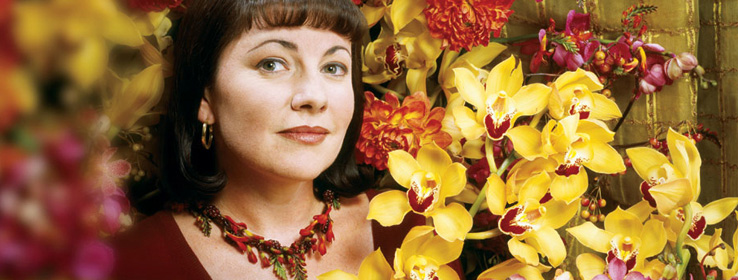Floral designer Sarah Hobden creates lasting impressions with temporal elements.
Some designs last a lifetime or even longer. Others are fleeting. Sarah Hobden's designs survive for only a week, at most. The creative director for Renny & Reed, a New York City florist and event-planning service, discusses her approach to color and the challenges of working with plants.
STIR: What's your first step when creating an arrangement?
SH: I always begin my day with an early-morning walk through the flower market. I do still get just blown away by flowers sometimes.
STIR: You work with a perishable and variable natural medium. How does that affect your approach to color?
SH: Most often my inspiration for color is derived from my medium. Many times a single flower will combine colors in a way that I have never thought of. For example, there is a bearded iris that is a silvery lilac with a shocking orange throat. I wouldn't have combined those two colors until seeing how beautiful they were together on the flower.
STIR: Tell us about your most challenging assignment. The arrangements at the Four Seasons Hotel in New York have been my most challenging work. It is a different design aesthetic than what I had been used to. The look there is much more architectural and contemporary than traditional flower design. Once I grasped the look, it was easy to embrace.
SH:
STIR: How do you develop seasonal palettes for your arrangements at the Four Seasons? Do you rely on colors we typically associate with the seasons, or do you like to use unexpected colors?
SH: I try to take advantage of what the season has to offer. There are many flowers that are around for only a limited time, so I try to incorporate them into my designs when I can. This doesn't mean orange in October or red in December, but it may mean using rich jewel-toned dahlias in burgundy and coral in September or yellow mini daffodils and green helleborus in April.
STIR: What are some of the most unusual items you've incorporated into floral arrangements?
SH: I was fortunate enough to learn floral design from a woman named Barbara Bockbrader in Massachusetts. Part of my job was to cut and process the flowers and then use them for designs. Everything in or around the gardens was fair game. Baby tomatoes still on the vine would be snipped and used in centerpieces, or mossy pieces of broken pots could be wired into arrangements for an earthy, organic style.
STIR: What tips do you have for designers on how to use flowers and plants most effectively?
SH: I think the most important aspect to using flowers is to recognize in them what is most beautiful and use them in a way that shows each one most effectively.
STIR: Can you elaborate?
SH: When using a perishable medium like flowers, you need to pay close attention to how long everything is going to last and how things are going to develop next to each other. Some things are going to fade really quickly. You need to make sure your major elements are going to last as long as you need them to.
STIR: What mistakes do people make when using flowers?
SH: Color is the most important aspect, and it's really important to pay attention to the individual flowers. Some people just stick flowers together because, say, they're yellow. But sometimes a flower will have more than one color in it. You really need to use that and use other colors that work with that.
STIR: What's your approach to flowers and plants in your own home? What colors do you tend to choose?
SH: I rarely have flowers at home. I think it is a little like the shoemaker's children having no shoes. I do, however, have a lot of plants. I tend to fall in love with large striking plants, and I am running out of space for them all. As for color, I always feel most attracted to warm tones and have a lot of brick reds and oranges. They create a very inviting and comfortable feeling, and they contrast well with the green color of all my plants.
STIR: Describe some other projects you've worked on. Your Web site lists some pretty high-profile clients, such as Diana Ross and the White House. I am fortunate in the variety of work I get to do, from beautiful hotels like the Four Seasons to large weddings in Beverly Hills, and garden terraces for penthouse apartments on Park Avenue. I am particularly excited to be taking on the designs at the Jumeirah Essex House in New York. It's a historic hotel off Central Park, and we are doing the lobby, restaurant and public locations.
SH:
STIR: If you could have chosen another career, what would it have been? Would it have been related to design?
SH: I probably would have been involved with horticulture or botany. I just love the plant and flower world too much to imagine doing anything else.




